Multidimensional Evaluation Model for Sustainable and Smart Urban Mobility in Global South Cities: A Citizen-Centred Comprehensive Framework
Abstract
1. Introduction
2. Materials and Methods
2.1. Literature Review
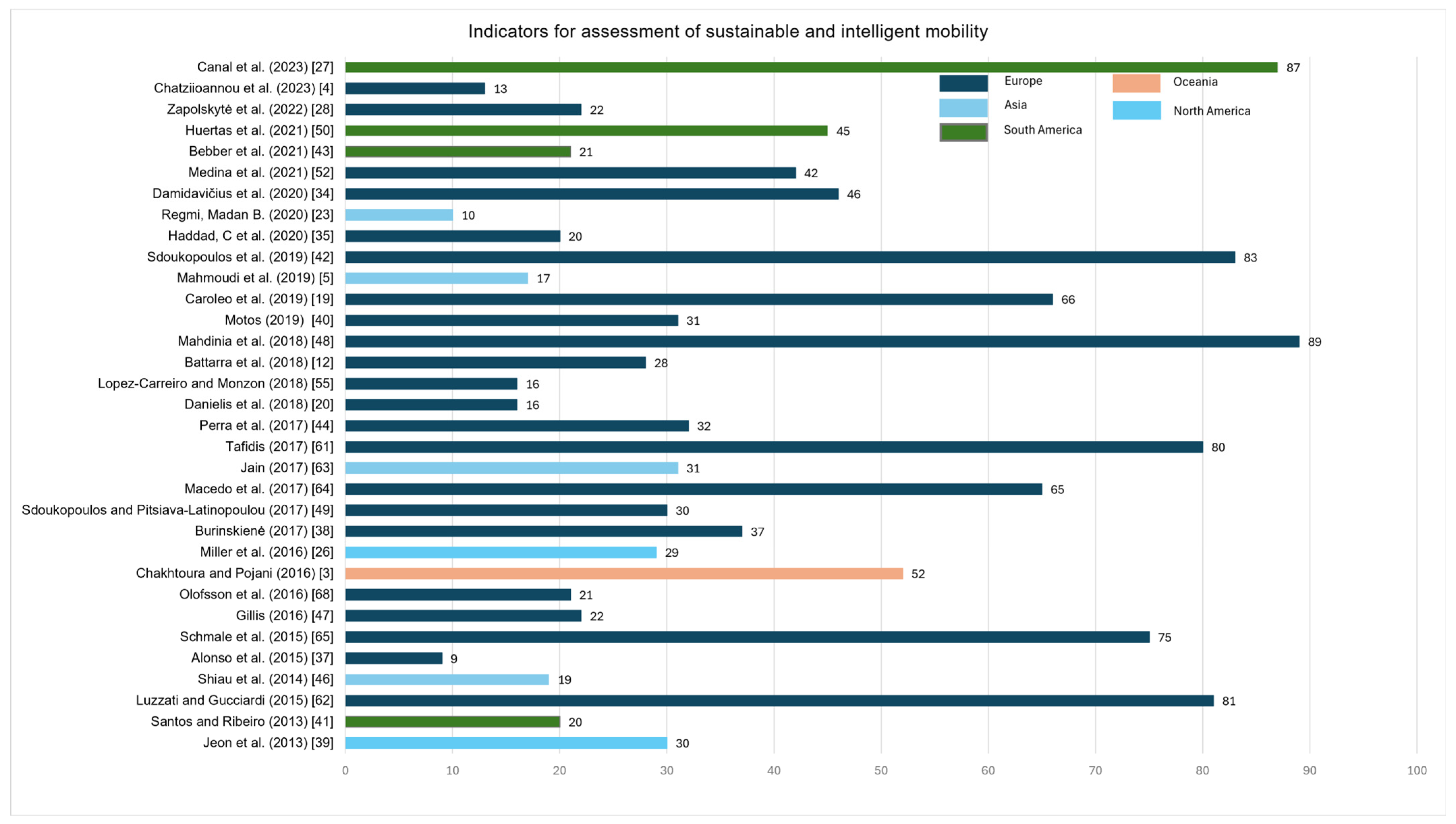
Background of the Governance Dimension
3. Proposal for a Citizen-Centred, Sustainable, and Intelligent Mobility Evaluation Model
3.1. Description Model
3.2. Validation and Prioritization of Model Components
- -
- In the social dimension, the city’s conditions are more relevant for mobility based on public transport, walking, and cycling, which are the foundations of sustainable mobility.
- -
- In the governance dimension, citizen participation, inclusion, and equity are essential in all planning, investment, and mobility monitoring stages.
- -
- In the environmental dimension, the impact of mobility on the global environment is emphasized.
- -
- In the economic dimension, the characteristics of public transport and its technology are very important. Still, if it presents better conditions for users and the environment, its number of users could increase.
3.3. Validation by Case Study
4. Results
4.1. Practical Results
4.1.1. Perception Surveys
4.1.2. Measurement Results by Authority and Online Data
4.2. Conceptual Results
5. Application Outlook and Potential Generalizability
5.1. Adaptability to Different Urban Scales
5.2. Regional Contextual Adjustments
5.3. Implementation Strategies for Resource-Constrained Environments
6. Discussion and Conclusions
Author Contributions
Funding
Institutional Review Board Statement
Informed Consent Statement
Data Availability Statement
Acknowledgments
Conflicts of Interest
References
- Hall, R.P. Understanding and Applying the Concept of Sustainable Development to Transportation Planning and Decision-Making in the U.S. Ph.D. Thesis, Massachusetts Institute of Technology, Cambridge, MA, USA, 2006; p. 872. [Google Scholar]
- United Nations. Objetivos y Metas de Desarrollo Sostenible—Desarrollo Sostenible. Available online: https://www.un.org/sustainabledevelopment/es/objetivos-de-desarrollo-sostenible/ (accessed on 2 July 2020).
- Chakhtoura, C.; Pojani, D. Indicator-Based Evaluation of Sustainable Transport Plans: A Framework for Paris and Other Large Cities. Transp. Policy 2016, 50, 15–28. [Google Scholar] [CrossRef]
- Chatziioannou, I.; Nikitas, A.; Tzouras, P.G.; Bakogiannis, E.; Alvarez-Icaza, L.; Chias-Becerril, L.; Karolemeas, C.; Tsigdinos, S.; Wallgren, P.; Rexfelt, O. Ranking Sustainable Urban Mobility Indicators and Their Matching Transport Policies to Support Liveable City Futures: A MICMAC Approach. Transp. Res. Interdiscip. Perspect. 2023, 18, 100788. [Google Scholar] [CrossRef]
- Mahmoudi, R.; Shetab-Boushehri, S.N.; Hejazi, S.R.; Emrouznejad, A. Determining the Relative Importance of Sustainability Evaluation Criteria of Urban Transportation Network. Sustain. Cities Soc. 2019, 47, 101493. [Google Scholar] [CrossRef]
- Gallo, M.; Marinelli, M. Sustainable Mobility: A Review of Possible Actions and Policies. Sustainability 2020, 12, 7499. [Google Scholar] [CrossRef]
- Tanikawa-Obregón, K.; Paz-Gómez, D.M. El Peatón Como Base de Una Movilidad Urbana Sostenible En Latinoamérica: Una Visión Para Construir Ciudades Del Futuro. Bol. Cienc. Tierra 2021, 29–34. [Google Scholar] [CrossRef]
- Brůhová Foltýnová, H.; Vejchodská, E.; Rybová, K.; Květoň, V. Sustainable Urban Mobility: One Definition, Different Stakeholders’ Opinions. Transp. Res. Part Transp. Environ. 2020, 87, 102465. [Google Scholar] [CrossRef]
- Spadaro, I.; Pirlone, F. Sustainable Urban Mobility Plan and Health Security. Sustainability 2021, 13, 4403. [Google Scholar] [CrossRef]
- Costa Braga, P.I.; Bezerra Dantas, H.F.; Deusdará Leal, M.R.; Rodrigues De Almeida, M.; Medeiros Dos Santos, E. Urban Mobility Performance Indicators: A Bibliometric Analysis. Gest. Prod. 2019, 26, e3828. [Google Scholar] [CrossRef]
- Albino, V.; Berardi, U.; Dangelico, R.M. Smart Cities: Definitions, Dimensions, Performance, and Initiatives. J. Urban Technol. 2015, 22, 3–21. [Google Scholar] [CrossRef]
- Battarra, R.; Gargiulo, C.; Tremiterra, M.R.; Zucaro, F. Smart Mobility in Italian Metropolitan Cities: A Comparative Analysis through Indicators and Actions. Sustain. Cities Soc. 2018, 41, 556–567. [Google Scholar] [CrossRef]
- Benevolo, C.; Dameri, R.P.; D’Auria, B. Smart Mobility in Smart City Action Taxonomy, ICT Intensity and Public Benefits. In Lecture Notes in Information Systems and Organisation; Springer: Berlin/Heidelberg, Germany, 2016; Volume 11, pp. 13–28. [Google Scholar]
- Caragliu, A.; del Bo, C.; Nijkamp, P. Smart Cities in Europe. J. Urban Technol. 2011, 18, 65–82. [Google Scholar] [CrossRef]
- Yigitcanlar, T.; Foth, M.; Kamruzzaman, M. Towards Post-Anthropocentric Cities: Reconceptualizing Smart Cities to Evade Urban Ecocide. J. Urban Technol. 2019, 26, 147–152. [Google Scholar] [CrossRef]
- Al-Thawadi, F.E.; Banawi, A.A.A.; Al-Ghamdi, S.G. Social Impact Assessment towards Sustainable Urban Mobility in Qatar: Understanding Behavioral Change Triggers. Transp. Res. Interdiscip. Perspect. 2021, 9, 8. [Google Scholar] [CrossRef]
- Banister, D. The Sustainable Mobility Paradigm. Transp. Policy 2008, 15, 73–80. [Google Scholar] [CrossRef]
- Barón, G.N. La transición urbana y social hacia un paradigma de movilidad sostenible. Cuad. Cent. Estud. Diseño Comun. 2020, 153–172. [Google Scholar] [CrossRef]
- Caroleo, B.; Morelli, N.; Lissandrello, E.; Vesco, A.; Dio, S.D.; Mauro, S. Measuring the Change Towards More Sustainable Mobility: MUV Impact Evaluation Approach. Systems 2019, 7, 30. [Google Scholar] [CrossRef]
- Danielis, R.; Rotaris, L.; Monte, A. Composite Indicators of Sustainable Urban Mobility: Estimating the Rankings Frequency Distribution Combining Multiple Methodologies. Int. J. Sustain. Transp. 2018, 12, 380–395. [Google Scholar] [CrossRef]
- Joumard, R.; Gudmundsson, H. Indicators of Environmental Sustainability in Transport: An Interdisciplinary Approach to Methods; Les Collections de l’INRETS: Bron, France, 2010; p. 427. ISBN 978-2-85782-684-2. [Google Scholar]
- Leśniewski, M.; Świąder, M.; Kaczmarek, I.; Castro, D.G.; Kamińska, J.A.; Pilawka, T.; Kazak, J.K. Towards Transit-Oriented Development for Sustainable Urban Mobility: Insights from a Central European City. Geomat. Environ. Eng. 2021, 15, 39–53. [Google Scholar] [CrossRef]
- Regmi, M.B. Measuring Sustainability of Urban Mobility: A Pilot Study of Asian Cities. Case Stud. Transp. Policy 2020, 8, 1224–1232. [Google Scholar] [CrossRef]
- Zietsman, J.; Rilett, L.R. Sustainable Transportation: Conceptualization and Performance Measures; Texas Transportation Institute; College Station: Texas, TX, USA, 2002; pp. 1–165. [Google Scholar]
- Lyons, G. Getting Smart about Urban Mobility – Aligning the Paradigms of Smart and Sustainable. Transp. Res. Part Policy Pract. 2018, 115, 4–14. [Google Scholar] [CrossRef]
- Miller, P.; de Barros, A.G.; Kattan, L.; Wirasinghe, S.C. Analyzing the Sustainability Performance of Public Transit. Transp. Res. Part Transp. Environ. 2016, 44, 177–198. [Google Scholar] [CrossRef]
- Canal, A.; César Pinto, P.; Vicente Filipak Vanin, D.; Isabel Hentges, T. Applying the Index of Sustainable Urban Mobility (I_SUM) in a Planned Small City: The Case of Itá, Brazil. Case Stud. Transp. Policy 2023, 14, 101109. [Google Scholar] [CrossRef]
- Zapolskytė, S.; Trépanier, M.; Burinskienė, M.; Survilė, O. Smart Urban Mobility System Evaluation Model Adaptation to Vilnius, Montreal and Weimar Cities. Sustainability 2022, 14, 715. [Google Scholar] [CrossRef]
- Angarita Lozano, D.L.; Diaz Marquez, S.E.; Morales Puentes, M.E. Sustainable and Smart Mobility Evaluation since Citizen Participation in Responsive Cities. Transp. Res. Procedia 2021, 58, 519–526. [Google Scholar] [CrossRef]
- Moreno, C. Vie Urbaine et Proximité à l’heure Du COVID-19; l’Observatoire/Humensis: Paris, France, 2020; p. 188. ISBN 979-10-329-1777-0. [Google Scholar]
- Rupprecht, S.; Brand, L.; Böhler-Baedecker, S.; Brunner, L.M. Guidelines for Developing and Implementing a Sustainable Urban Mobility Plan; Rupprecht Consult: Cologne, Germany, 2019; p. 168. [Google Scholar]
- Ministerio de Transporte de Colombia. Resolución 20203040015885; Ministerio de Transporte de Colombia: Bogotá, Colombia, 2020; p. 34. [Google Scholar]
- Goepel, K.D. Implementation of an Online Software Tool for the Analytic Hierarchy Process (AHP-OS). Int. J. Anal. Hierarchy Process 2018, 10, 469–487. [Google Scholar]
- Damidavičius, J.; Burinskienė, M.; Antuchevičienė, J. Assessing Sustainable Mobility Measures Applying Multicriteria Decision Making Methods. Sustainability 2020, 12, 6067. [Google Scholar] [CrossRef]
- Haddad, C.A.; Fu, M.; Straubinger, A.; Plötner, K.; Antoniu, C. Choosing Suitable Indicators for the Assessment of Urban Air Mobility: A Case Study of Upper Bavaria, Germany. Eur. J. Transp. Infrastruct. Res. 2020, 20, 214–232. [Google Scholar] [CrossRef]
- Angarita-Lozano, D.; Rodriguez-Hernández, A.; Mendoza-Moreno, M.; Díaz-Marquez, S.; Morales-Puentes, M. Responsive Mobility (Evaluación de La Movilidad). Available online: https://www.responsivemobility.com (accessed on 13 December 2023).
- Alonso, A.; Monzón, A.; Cascajo, R. Comparative Analysis of Passenger Transport Sustainability in European Cities. Ecol. Indic. 2015, 48, 578–592. [Google Scholar] [CrossRef]
- Burinskienė, M.; Gaučė, K.; Damidavičius, J. Successful Sustainable Mobility Measures Selection. In Proceedings of the 10th International Conference on Environmental Engineering, ICEE 2017, Vilnius, Lithuania, 27–28 April 2017; p. 7. [Google Scholar]
- Jeon, C.M.; Amekudzi, A.A.; Guensler, R.L. Sustainability Assessment at the Transportation Planning Level: Performance Measures and Indexes. Transp. Policy 2013, 25, 10–21. [Google Scholar] [CrossRef]
- Motos Cascales, G. Análisis de Indicadores de Movilidad Urbana Sostenible. Master´s Thesis, Universidad Politécnica de Cartagena, Cartagena, España, 2019; p. 134. [Google Scholar]
- Santos, A.S.; Ribeiro, S.K. The Use of Sustainability Indicators in Urban Passenger Transport during the Decision-Making Process: The Case of Rio de Janeiro, Brazil. Curr. Opin. Environ. Sustain. 2013, 5, 251–260. [Google Scholar] [CrossRef]
- Sdoukopoulos, A.; Pitsiava-Latinopoulou, M.; Basbas, S.; Papaioannou, P. Measuring Progress towards Transport Sustainability through Indicators: Analysis and Metrics of the Main Indicator Initiatives. Transp. Res. Part Transp. Environ. 2019, 67, 316–333. [Google Scholar] [CrossRef]
- Bebber, S.; Libardi, B.; De Atayde Moschen, S.; Correa da Silva, M.B.; Cristina Fachinelli, A.; Nogueira, M.L. Sustainable Mobility Scale: A Contribution for Sustainability Assessment Systems in Urban Mobility. Clean. Eng. Technol. 2021, 5, 100271. [Google Scholar] [CrossRef]
- Perra, V.M.; Sdoukopoulos, A.; Pitsiava-Latinopoulou, M. Evaluation of Sustainable Urban Mobility in the City of Thessaloniki. Transp. Res. Procedia 2017, 24, 329–336. [Google Scholar] [CrossRef]
- Guimarães, J.G.d.A. Cidades Inteligentes: Proposta de Um Modelos Brasileiro Multi Ranking de Classificação. Ph.D. Thesis, Universidade de São Paulo, São Paulo, Brazil, 2018; p. 278. [Google Scholar]
- Shiau, T.A.; Huang, M.W.; Lin, W.Y. Developing an Indicator System for Measuring Taiwan’s Transport Sustainability. Int. J. Sustain. Transp. 2014, 9, 81–92. [Google Scholar] [CrossRef]
- Gillis, D.; Semanjski, I.; Lauwers, D. How to Monitor Sustainable Mobility in Cities? Literature Review in the Frame of Creating a Set of Sustainable Mobility Indicators. Sustainability 2016, 8, 29. [Google Scholar] [CrossRef]
- Mahdinia, I.; Habibian, M.; Hatamzadeh, Y.; Gudmundsson, H. An Indicator-Based Algorithm to Measure Transportation Sustainability: A Case Study of the U.S. States. Ecol. Indic. 2018, 89, 738–754. [Google Scholar] [CrossRef]
- Sdoukopoulos, A.; Pitsiava-Latinopoulou, M. Assessing Urban Mobility Sustainability through a System of Indicators: The Case of Greek Cities. WIT Trans. Ecol. Environ. 2017, 226, 617–631. [Google Scholar] [CrossRef]
- Huertas, J.I.; Stöffler, S.; Fernández, T.; García, X.; Castañeda, R.; Serrano-guevara, O.; Mogro, A.E.; Alvarado, D.A. Methodology to Assess Sustainable Mobility in LATAM Cities. Appl. Sci. 2021, 11, 34. [Google Scholar] [CrossRef]
- Litman, T. Developing Indicators for Sustainable and Livable Transport Planning; Victoria Transport Policy Institute: Victoria, BC, Canada, 2021; p. 116. [Google Scholar]
- Medina, J.C.; Pinho de Sousa, J.; Jimenez Perez, E. Defining and Prioritizing Indicators to Assess the Sustainability of Mobility Systems in Emerging Cities. In Proceedings of the Advances in Mobility-as-a-Service Systems; Nathanail, E.G., Adamos, G., Karakikes, I., Eds.; Springer International Publishing: Berlin/Heidelberg, Germany, 2021; Volume 1278, pp. 616–625. [Google Scholar]
- Jeon, C.M.; Amekudzi, A. Addressing Sustainability in Transportation Systems: Definitions, Indicators, and Metrics. J. Infrastruct. Syst. 2005, 11, 31–50. [Google Scholar] [CrossRef]
- Sharifi, A. A Typology of Smart City Assessment Tools and Indicator Sets. Sustain. Cities Soc. 2020, 53, 101936. [Google Scholar] [CrossRef]
- Lopez-Carreiro, I.; Monzon, A. Evaluating Sustainability and Innovation of Mobility Patterns in Spanish Cities. Analysis by Size and Urban Typology. Sustain. Cities Soc. 2018, 38, 684–696. [Google Scholar] [CrossRef]
- United Nations; ESCAP. Assessment of Urban Transport System; ESCAP: Bangkok, Thailand, 2017; p. 78. ISBN 978-92-1-362888-1. [Google Scholar]
- European Commission. Sustainable Urban Mobility Indicators: Harmonisation Guideline; European Commission: Brussels, Belgium, 2020; p. 25. [Google Scholar]
- ISO 37120:2018; Sustainable Cities and Communities—Indicators for City Services and Quality of Life. International Organization for Standardization: Genève, Switzerland, 2018; p. 121.
- Chestnut, J.; Associate, R.; Mason, J. Indicators for Sustainable Mobility; Institute for Transportation and Development Policy ITDP: New York, NY, USA, 2019; p. 44. [Google Scholar]
- WBCSD. Methodology and Indicator Calculation Method for World Business Council for Sustainable Development Sustainable Mobility Project 2.0 (SMP2.0) Indicators Work Stream Sustainable Urban Mobility; World Business Council for Sustainable Development: Geneva, Switzerland, 2020; p. 64. [Google Scholar]
- Tafidis, P.; Sdoukopoulos, A.; Pitsiava-Latinopoulou, M. Sustainable Urban Mobility Indicators: Policy versus Practice in the Case of Greek Cities. Transp. Res. Procedia 2017, 24, 304–312. [Google Scholar] [CrossRef]
- Luzzati, T.; Gucciardi, G. A Non-Simplistic Approach to Composite Indicators and Rankings: An Illustration by Comparing the Sustainability of the EU Countries. Ecol. Econ. 2015, 113, 25–38. [Google Scholar] [CrossRef]
- Jain, D.; Tiwari, G. Sustainable Mobility Indicators for Indian Cities: Selection Methodology and Application. Ecol. Indic. 2017, 79, 310–322. [Google Scholar] [CrossRef]
- Macedo, J.; Rodrigues, F.; Tavares, F. Urban Sustainability Mobility Assessment: Indicators Proposal. In Proceedings of the Energy Procedia; Elsevier Ltd.: Chania, Greece, 2017; Volume 134, pp. 731–740. [Google Scholar]
- Schmale, J.; von Schneidemesser, E.; Dörrie, A. An Integrated Assessment Method for Sustainable Transport System Planning in a Middle Sized German City. Sustainability 2015, 7, 1329–1354. [Google Scholar] [CrossRef]
- Filippi, F. A Paradigm Shift for a Transition to Sustainable Urban Transport. Sustainability 2022, 14, 2853. [Google Scholar] [CrossRef]
- Ortúzar, J.d.D. Sustainable Urban Mobility: What Can Be Done to Achieve It? J. Indian Inst. Sci. 2019, 99, 683–693. [Google Scholar] [CrossRef]
- Olofsson, Z.; Hiselius, L.; Várhelyi, A. Development of a Tool to Assess Urban Transport Sustainability: The Case of Swedish Cities. Int. J. Sustain. Transp. 2016, 10, 645–656. [Google Scholar] [CrossRef]
- Loorbach, D.; Schwanen, T.; Doody, B.J.; Arnfalk, P.; Langeland, O.; Farstad, E. Transition Governance for Just, Sustainable Urban Mobility: An Experimental Approach from Rotterdam, the Netherlands. J. Urban Mobil. 2021, 1, 100009. [Google Scholar] [CrossRef]
- Docherty, I.; Marsden, G.; Anable, J. The Governance of Smart Mobility. Transp. Res. Part Policy Pract. 2018, 115, 114–125. [Google Scholar] [CrossRef]
- Cirolia, L.R.; Harber, J.; Croese, S. Governing Mobility in Sub-Saharan African Cities; The Volvo Research and Educational Foundations, VREF: Gothenburg, Sweden, 2020; p. 37. [Google Scholar]
- Arellana, J.; Oviedo, D.; Guzman, L.A.; Alvarez, V. Urban Transport Planning and Access Inequalities: A Tale of Two Colombian Cities. Res. Transp. Bus. Manag. 2021, 40, 100554. [Google Scholar] [CrossRef]
- Venter, C.; Mahendra, A.; Hidalgo, D. From Mobility to Access for All: Expanding Urban Transportation Choices in the Global South; Cities for all; World Resources Institute: Washington, DC, USA, 2019; p. 48. [Google Scholar]
- Saaty, T. Toma de Decisiones Para Líderes. El Proceso Analítico Jerárquico; RWS Publications; University of Pittsburgh: Pittsburgh, PA, USA, 2014; p. 415. ISBN 978-1-8888603-29-3. [Google Scholar]
- Pacheco, J.F.; Contreras, E. Manual Para La Evaluación Multicriterio Para Programas y Proyectos; CEPAL, Ed.; United Nations CEPAL: Santiago de Chile, Chile, 2008; p. 111. ISBN 978-92-1-323231-6. [Google Scholar]
- MINTIC—Ministerio de Tecnologías de la Información y Comunicaciones de Colombia. Modelo de Medición de Madurez de Ciudades y Territorios Inteligentes Para Colombia; MINTIC: Bogotá, Colombia, 2021; pp. 1–36. [Google Scholar]
- Departamento Nacional de Planeación—DNP. Sistema de Ciudades: Una Política Nacional Para El Sistema de Ciudades Colombiano Con Visión a Largo Plazo; Departamento Nacional de Planeación—DNP: Bogotá, Colombia, 2014; p. 154. [Google Scholar]
- Departamento Administrativo Nacional de Estadística. Proyecciones y Retroproyecciones de Población Municipal Para El Periodo 1985-2019 y 2020–2035 Con Base En El CNPV 2018; Departamento Administrativo Nacional de Estadística: Bogotá, Colombia, 2023. [Google Scholar]
- Romero Torres, J.; Sánchez, N.; Bautista Lara, E. Percepción de La Satisfacción Del Servicio En El Transporte Público Solo Para Mujeres. Rev. Transp. Territ. 2016, 164–182. [Google Scholar] [CrossRef]
- Agencia Nacional de Seguridad Vial Observatorio Nacional de Seguridad Vial. Available online: https://ansv.gov.co/es/observatorio/estadísticas (accessed on 13 December 2022).
- Departamento Administrativo Nacional de Estadística Censo Nacional de Población y Vivienda. 2018. Available online: https://www.dane.gov.co/index.php/estadisticas-por-tema/demografia-y-poblacion (accessed on 20 December 2022).
- Alcaldía de Ibagué. Decreto 0835 de 2022 Plan Maestro de Movilidad y Espacio Público de Ibagué; Alcaldía de Ibagué: Ibagué, Colombia, 2022; Volume 0835–2022, p. 8. [Google Scholar]
- Alcaldía de Tunja. Plan de Ordenamiento Territorial de Tunja; Alcaldía de Tunja: Tunja, Colombia, 2022. [Google Scholar]
- Goss-Sampson, M. Análisis Estadístico Con JASP: Una Guía Para Estudiantes; Universitat Oberta de Catalunya: Barcelona, Spain, 2019; p. 132. [Google Scholar]
- Ventura-León, J.; Caycho-Rodriguez, T. El Coeficiente Omega: Un Método Alternativo Para La Estimación de La Confiabilidad. Rev. Latinoam. Cienc. Soc. Niñez Juv. 2017, 15, 625–627. [Google Scholar]
- Campo-Arias, A.; Oviedo, H. Propiedades Psicométricas de Una Escala: La Consistencia Interna. Rev. Salud Pública 2008, 10, 831–839. [Google Scholar] [CrossRef]
- Rico Ospina, L.P. Estudio de Emisiones de Gases de Efecto Invernadero Relacionadas Con La Implementación de Autobuses Eléctricos En La Flota de Transporte Urbano Colectivo de La Ciudad de Ibagué. Master´s Thesis, Universidad Nacional de Colombia, Bogotá, Colombia, 2021. [Google Scholar]
- Sheller, M.; Urry, J. The New Mobilities Paradigm. Environ. Plan. A 2006, 38, 207–226. [Google Scholar] [CrossRef]
- Watson, V. Seeing from the South: Refocusing Urban Planning on the Globe’s Central Urban Issues. Urban Stud. 2009, 46, 2259–2275. [Google Scholar] [CrossRef]
- Oviedo Hernandez, D.; Dávila, J.D. Transport, Urban Development and the Peripheral Poor in Colombia—Placing Splintering Urbanism in the Context of Transport Networks. J. Transp. Geogr. 2016, 51, 180–192. [Google Scholar] [CrossRef]
- Dimitriou, H.T. Towards a Generic Sustainable Urban Transport Strategy for Middle-Sized Cities in Asia: Lessons from Ningbo, Kanpur and Solo. Habitat Int. 2006, 30, 1082–1099. [Google Scholar] [CrossRef]
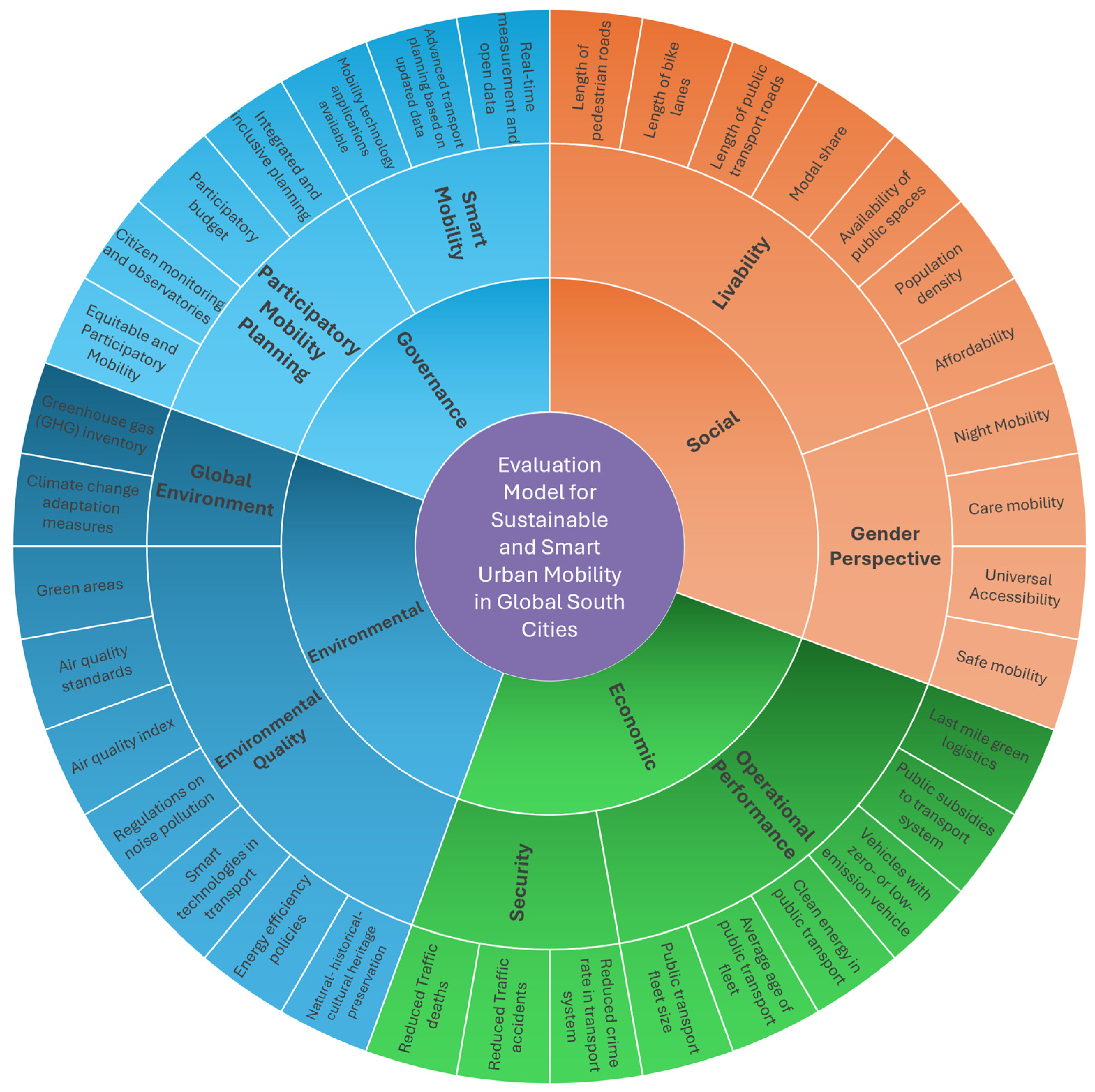
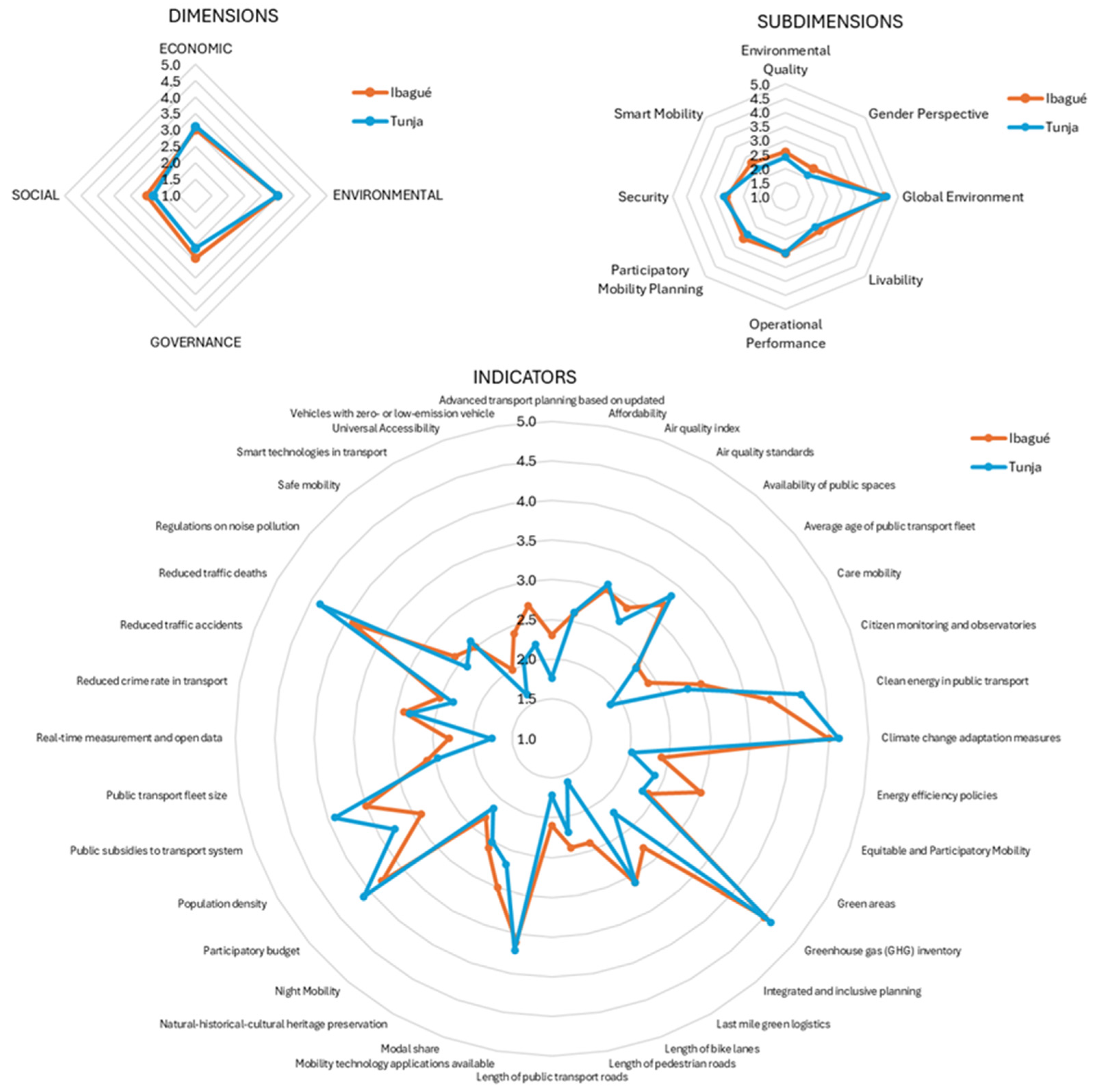
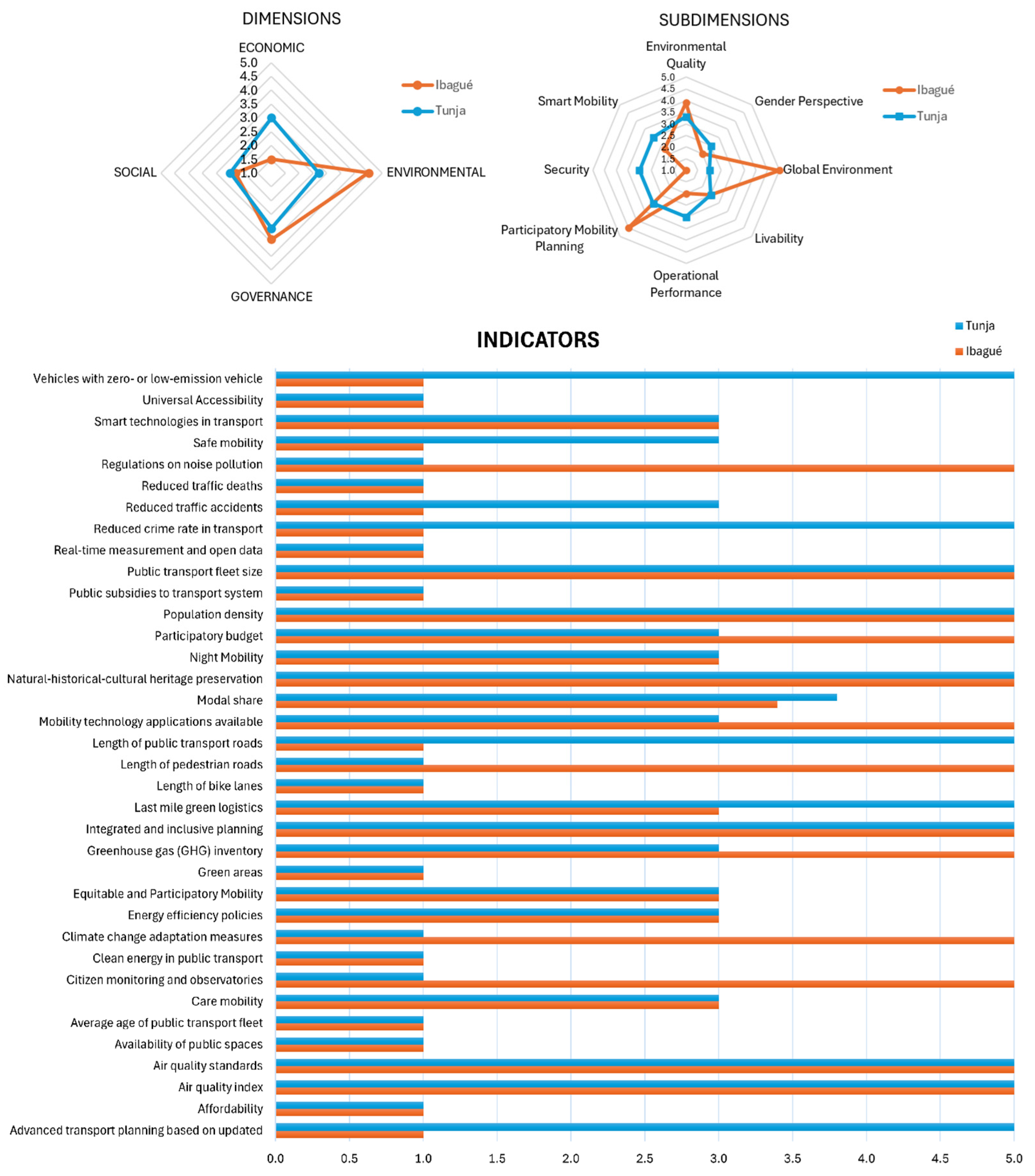

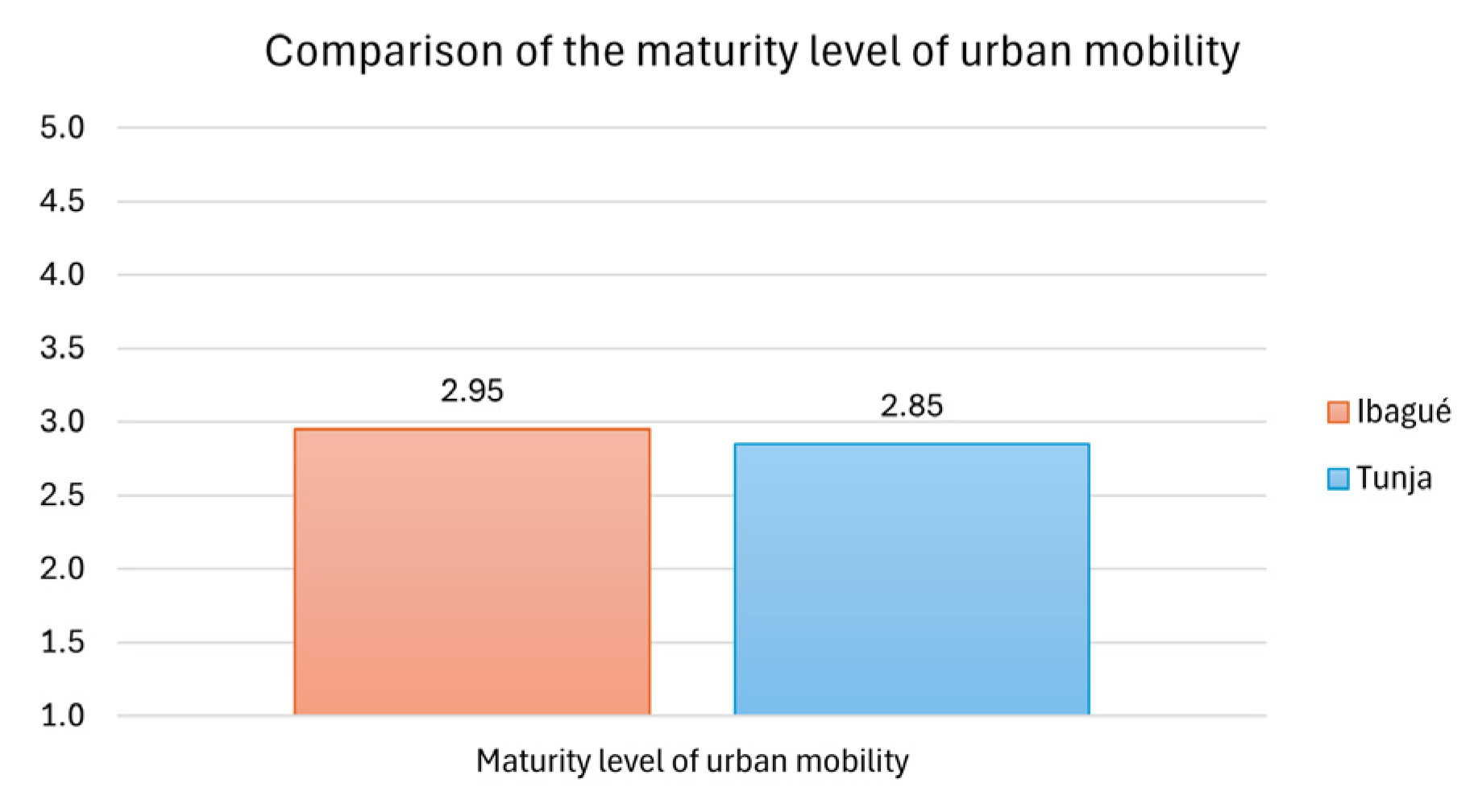
| Fundamental Characteristics | Implementation Characteristics | Contextual Relevance | ||||||||
|---|---|---|---|---|---|---|---|---|---|---|
| Framework | Origin and Institutional Backing | Geographic Focus | Target Audience | Data Requirements | Citizen Perception Integration | Adaptability to Data Constraints | Scalability Across City Sizes | Global South Adaptability | Practical Implementation Evidence | Maturity Assessment Capability |
| SUTI [56] | United Nations, 2017 | Asian cities | City planners, local authorities | High | Limited (some satisfaction surveys) | Limited adaptability | Focused on Asian cities | Limited (Asian focus) | Applied in Asian cities | Limited (project assessment focus) |
| SUMI [57] | European Commission, 2017 | European Union cities | Municipal authorities, E.U. institutions | Very high (detailed transport data) | Limited (some satisfaction surveys) | Low (designed for data-rich environments) | Better for larger cities | Limited (designed for E.U. context) | Extensive in E.U. | Moderate (benchmarking capability) |
| ISO 37120 [58] | International Organization for Standardization, 2018 | Global cities | Municipal governments, standard bodies | High (standardized data) | Not included | Low (rigid requirements) | Adaptable but resource-intensive for small cities | Moderate (global standard) | Global application but limited in developing regions | Limited (certification levels only) |
| Transport System Indicators [42] | Academic research, 2019 | Developed countries | Stakeholders | High | Not included | Low | Medium to large cities | Strong (global application) | Not included | Not included |
| ITDP Indicators [59] | Institute for Transportation and Development Policy, 2019 | Global cities | Urban planners, developers, municipalities | Moderate (focused on built environment) | Not included | Moderate (visual assessments possible) | Applicable to neighbourhoods in any size city | Strong (global application) | Limited to U.S. cities | Not included |
| WBCSD Sustainable Mobility 2.0 [60] | World Business Council for Sustainable Development, 2015 | Global cities | Businesses, city officials | High | Limited (some satisfaction surveys) | Low | Larger city focus | Moderate | Not included | Limited (targets without stages) |
| Structural Elements | Content Focus | |||||||
|---|---|---|---|---|---|---|---|---|
| Framework | Dimensional Structure | Assessment Methodology | Weighting Approach | Environmental Dimension | Social Dimension | Economic Dimension | Governance Dimension | Smart/Technological Integration |
| SUTI [56] | 4 dimensions (economic, environmental, social, transport system) | Quantitative metrics | Equal weighting | Moderate (air quality, GHG emissions) | Strong (access, safety) | Limited (operational metrics) | Not included | Not included |
| SUMI [57] | 9 areas | Primarily quantitative | Theme-based weights | Strong (emissions, energy, noise) | Moderate (accessibility, safety) | Moderate (congestion costs) | Limited to planning aspects | Moderate (ITS, shared mobility) |
| ISO 37120 [58] | 19 themes (transport is one section) | Standardized quantitative metrics | No explicit weighting | Moderate (air quality, GHG, noise) | Moderate (standard safety metrics) | Limited (operational metrics) | Not included in transport | Limited technical indicators |
| Transport System Indicators [42] | 3 pillars (economic, environmental, social) | Quantitative | No explicit weighting | Strong (emissions, noise, energy) | Limited (population characteristics) | Moderate (transport cost, subsidies) | Limited governance considerations | Minimal technology focus |
| ITDP Indicators [59] | 3 categories (proximity to transit, accessibility, and city characteristics) | Point-based scoring system | Varied points per metric | Moderate (walking, biking) | Strong (walkability, accessibility) | Moderate (low-income households rapid or frequent transit) | Not included | Minimal technology focus |
| WBCSD Sustainable Mobility 2.0 [60] | 4 areas | Point-based scoring system | Equal weighting | Strong (emissions, energy, GHG) | Strong (access, safety) | Strong (productivity, economic opportunity) | Implicit in implementation | Moderate (optimized utilization) |
| Dimension | Priority | Rank |
|---|---|---|
| Social | 34.1% | 1 |
| Governance | 23.9% | 2 |
| Environmental | 23.6% | 3 |
| Economic | 18.5% | 4 |
| Dimension | Subdimension | Priority | Rank | Indicators | Priority | Rank |
|---|---|---|---|---|---|---|
| Social | Affordability | 19.9% | 1 | |||
| Length of pedestrian roads | 14.9% | 2 | ||||
| Modal share | 14.2% | 3 | ||||
| Livability | 71.9% | 1 | Availability of public spaces | 13.6% | 4 | |
| Length of public transport roads | 13.4% | 5 | ||||
| Length of bike lanes | 12.0% | 6 | ||||
| Population density | 11.9% | 7 | ||||
| Social | Universal accessibility | 31.9% | 1 | |||
| Gender Perspective | 28.1% | 2 | Safe mobility | 31.7% | 2 | |
| Care mobility | 22.7% | 3 | ||||
| Night mobility | 13.7% | 4 | ||||
| Governance | Integrated and inclusive planning | 37.3% | 1 | |||
| Participatory Mobility Planning | 75.5% | 1 | Equitable and participatory mobility | 24.6% | 2 | |
| Citizen monitoring and observatories | 22.5% | 3 | ||||
| Participatory budget | 15.7% | 4 | ||||
| Governance | Advanced transport planning based on updates | 39.8% | 1 | |||
| Smart Mobility | 24.5% | 2 | Real-time measurement and open data | 35.0% | 2 | |
| Mobility technology applications available | 25.2% | 3 | ||||
| Environmental | Global Environment | 61.2% | 1 | Climate change adaptation measures | 55.5% | 1 |
| Greenhouse gas (GHG) inventor | 44.5% | 2 | ||||
| Environmental | Energy efficiency policies | 20.3% | 1 | |||
| Air quality index | 15.9% | 2 | ||||
| Air quality standards | 14.5 | 3 | ||||
| Environmental Quality | 38.8% | 2 | Green areas | 14.2% | 4 | |
| Regulations on noise pollution | 12.1% | 5 | ||||
| Smart technologies in transport | 12.0% | 6 | ||||
| Natural–historical–cultural heritage preservation | 11.0% | 7 | ||||
| Economic | Reduced traffic deaths | 49.4% | 1 | |||
| Security | 60.0% | 1 | Reduced traffic accidents | 35.2% | 2 | |
| Reduced crime rate in transport | 15.4% | 3 | ||||
| Economic | Public subsidies to the transport system | 25.6% | 1 | |||
| Clean energy in public transport | 19.4% | 2 | ||||
| Operational Performance | 40.0% | 2 | Vehicles with zero or low emissions | 17.4% | 3 | |
| Average age of the public transport fleet | 13.0% | 4 | ||||
| Last-mile green logistics | 12.3% | 5 | ||||
| Public transport fleet size | 12.3% | 6 |
| Maturity Level | Level 1 | Level 2 | Level 3 | Level 4 | Level 5 |
|---|---|---|---|---|---|
| By citizen perception | Citizens perceive that the indicators used to evaluate the city’s mobility have worsened and/or affected their quality of life. | Citizens do not observe any progress in the indicators used to evaluate the city’s mobility. At least two assessed dimensions are noted, and the evaluation score is lower than 3. | Citizens perceive a modest improvement in the metrics utilized to assess the city’s mobility. An evaluation exceeding 3 is achieved in a minimum of two of the assessment dimensions. | Citizens observe improvements in mobility assessment indicators; however, these advancements do not directly influence their quality of life. A minimum score of 4.0 must be achieved in two or more evaluated dimensions. | Citizens perceive significant progress in the indicators for evaluating the city’s sustainable and intelligent mobility, which is evidenced in its quality of life. An evaluation higher than 4.0 is obtained in the four dimensions evaluated. |
| By measuring results | The evaluation indicators show poor planning and management of city mobility, which worsens the associated problems. | The evaluation indicators show the absence of sustainable and intelligent criteria in the planning and management of city mobility. | Evaluation indicators show little significant progress towards achieving sustainable and intelligent mobility. Its results are not enough to solve the associated problems. | Evaluation indicators demonstrate considerable progress in planning and managing sustainable and intelligent urban development mobility. | The evaluation indicators show that the pillars of sustainability and citizen participation support the planning and management of urban mobility. |
| General | Very low | Low | Medium | High | Very high |
| Characteristic | Proposed Model | |
|---|---|---|
| Fundamental Characteristics | Origin and Institutional Backing | Academic research, 2023 |
| Geographic Focus | Global South cities | |
| Target Audience | City officials, planners, citizens | |
| Structural Elements | Dimensional Structure | 4 dimensions (environmental, social, economic, governance) |
| Assessment Methodology | Mixed methods (quantitative + perception) | |
| Weighting Approach | AHP expert-derived weights | |
| Content Focus | Environmental Dimension | Strong (global + local impacts) |
| Social Dimension | Strong (livability, gender perspective) | |
| Economic Dimension | Strong (operational, safety) | |
| Governance Dimension | Strong (dedicated dimension) | |
| Smart/Technological Integration | Strong (smart mobility sub-dimension) | |
| Implementation Characteristics | Data Requirements | Moderate |
| Citizen Perception Integration | Strong (dedicated perception surveys) | |
| Adaptability to Data Constraints | High (adaptable to available data) | |
| Scalability Across City Sizes | High (adaptable to different city scales) | |
| Contextual Relevance | Global South Adaptability | Very strong (Global South focus) |
| Practical Implementation Evidence | Case studies in Colombian cities | |
| Maturity Assessment Capability | Strong (5-level maturity scale) |
Disclaimer/Publisher’s Note: The statements, opinions and data contained in all publications are solely those of the individual author(s) and contributor(s) and not of MDPI and/or the editor(s). MDPI and/or the editor(s) disclaim responsibility for any injury to people or property resulting from any ideas, methods, instructions or products referred to in the content. |
© 2025 by the authors. Licensee MDPI, Basel, Switzerland. This article is an open access article distributed under the terms and conditions of the Creative Commons Attribution (CC BY) license (https://creativecommons.org/licenses/by/4.0/).
Share and Cite
Angarita-Lozano, D.; Hidalgo-Guerrero, D.; Díaz-Márquez, S.; Morales-Puentes, M.; Mendoza-Moreno, M.A. Multidimensional Evaluation Model for Sustainable and Smart Urban Mobility in Global South Cities: A Citizen-Centred Comprehensive Framework. Sustainability 2025, 17, 4684. https://doi.org/10.3390/su17104684
Angarita-Lozano D, Hidalgo-Guerrero D, Díaz-Márquez S, Morales-Puentes M, Mendoza-Moreno MA. Multidimensional Evaluation Model for Sustainable and Smart Urban Mobility in Global South Cities: A Citizen-Centred Comprehensive Framework. Sustainability. 2025; 17(10):4684. https://doi.org/10.3390/su17104684
Chicago/Turabian StyleAngarita-Lozano, Diana, Darío Hidalgo-Guerrero, Sonia Díaz-Márquez, María Morales-Puentes, and Miguel Angel Mendoza-Moreno. 2025. "Multidimensional Evaluation Model for Sustainable and Smart Urban Mobility in Global South Cities: A Citizen-Centred Comprehensive Framework" Sustainability 17, no. 10: 4684. https://doi.org/10.3390/su17104684
APA StyleAngarita-Lozano, D., Hidalgo-Guerrero, D., Díaz-Márquez, S., Morales-Puentes, M., & Mendoza-Moreno, M. A. (2025). Multidimensional Evaluation Model for Sustainable and Smart Urban Mobility in Global South Cities: A Citizen-Centred Comprehensive Framework. Sustainability, 17(10), 4684. https://doi.org/10.3390/su17104684









